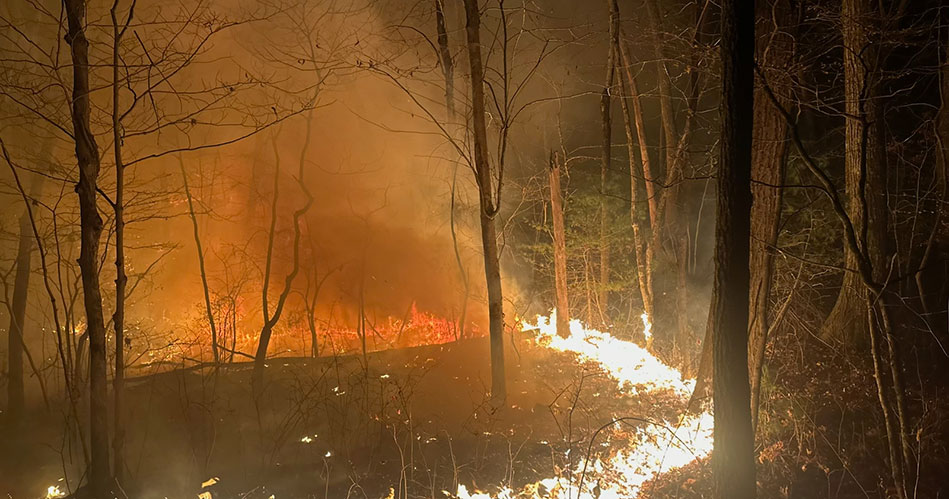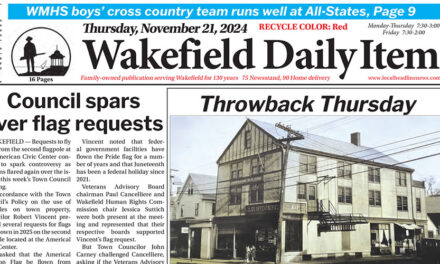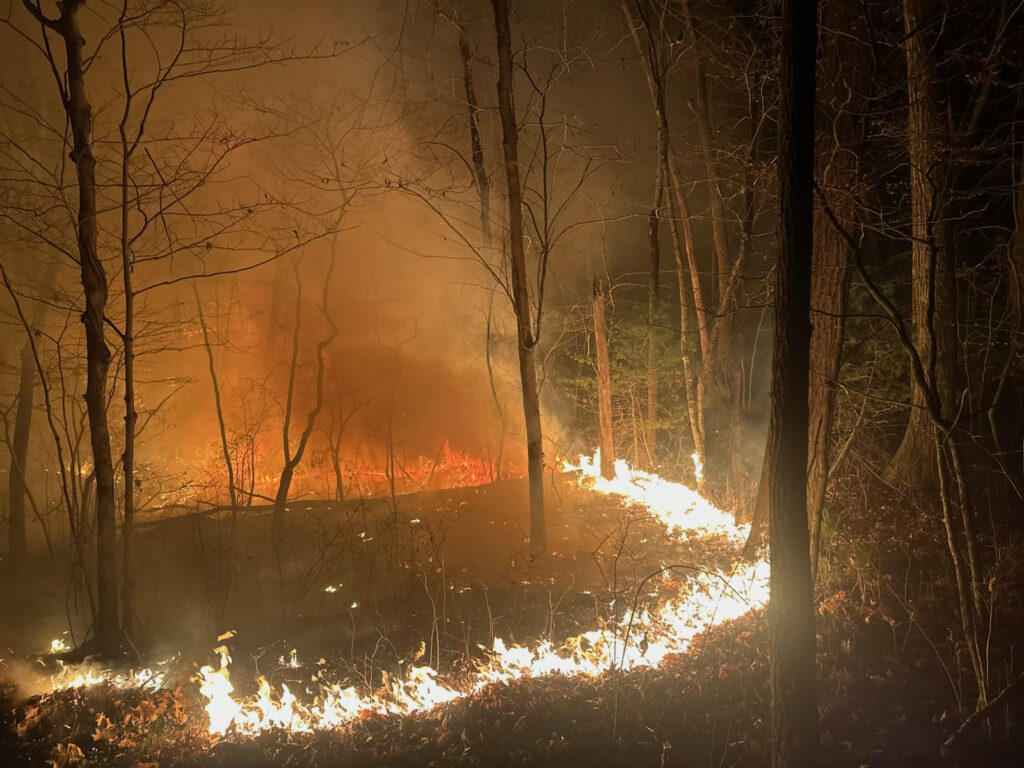
LINE OF FIRE. Fires raged in the woods on the eastern side of town over a 17-day period near the Middleton line with plenty of fuel provided by thick layers of leaf litter in the understory and an ongoing drought. (NRFD Courtesy Photo)
By MAUREEN DOHERTY
NORTH READING — There’s only one word to describe how the town’s Fire Department endured 17 consecutive days of forest and brush fires: teamwork.
For days on end, the department battled the flames and the flare ups, the smoke and the falling trees, often under harrowing conditions and at night, including a stretch over the Veterans Day weekend when conditions warranted second and third alarms. And we’re not out of the woods yet.
“This is an extension of the fire that started in Middleton under the power lines behind Upton Hills. It worked south and east. Middleton has roughly a 180-acre section, and 53 acres of that now are ours. It backs into North Reading by way of Dogwood Lane as the outer boundary of the North Reading section,” explained Fire Chief Don Stats, who has been coordinating the firefighting operation in town.
The fire had not only crossed the town boundaries between North Reading and Middleton, but also crossed into a combination of privately owned land, including house lots, as well as town forest and land owned by National Grid for its power line easement in Middleton. There are also many active trails in these woods used by mountain bikers, ATVs, UTVs, walkers, hunters and nature enthusiasts.

TEAMS OF LEAF BLOWERS from the North Reading DPW were crucial to maintaining a fire break between nearby homes and the areas of active fire being battled by firefighters deeper in the woods for several consecutive days during the fires that charred 53 acres of woodland in town. (NRFD Courtesy Photo)
North Reading and Middleton are just two out of dozens of communities throughout the state battling the same conditions that have been fueling numerous woodland fires — an extensive drought and lots of fuel created by a deep understory of dry leaves and branches. These tinderbox conditions have caused the entire state to currently be under another red flag warning due to the combination of warm temperatures, low humidity and strong winds which can rapidly spread fire from sources as small as sparks or embers, therefore, firepits and charcoal grills should not be used under these conditions and outdoor burning is prohibited. There was rain in the forecast for today (Nov. 21), but it may not be enough to make up for the deficit at this point.
Stats said that until we get several days of soaking rain the threat for flare ups will continue. And if it doesn’t rain soon, we’ll have to wait for the snow and freezing temperatures. “As far as the end in sight, until we get some decent precipitation for a few days in the form of rain or we get a decent snowfall and a freeze, we’re going to anticipate seeing smoldering hotspots in places,” he said.
“Fabulous response”
Stats said his department’s response has been “fabulous!”
“Knowing our callback system and how we’re staffed, the majority of my department answered the call,” he said. Utilizing a combination of his on-duty staff and the extended day callbacks, he would have between six to nine off-duty members on scene too. “So I had at any one time 12 to 15 people from North Reading Fire in the woods every day. And we backfilled the station with mutual aid companies for engines to handle the daily calls while we dealt with the fire,” he said.
“Nothing makes firemen more happy than some work and getting to do our jobs. Camaraderie is built off of this. I hate to say it like that. We all like to work. We don’t like to see anybody lose anything, of course, but at the same time it does bring everybody together,” he said. “It’s been stressful but it’s been good that my guys moving forward should carry (this experience) with them for the rest of their careers.”
And all of the fires to date have been contained to the woodlands without any structural losses.
They had set up a system to shuttle water from a couple of different staging areas and used an estimated average of 50,000 gallons of water per day. “We had set up in the yard (at 3 Dogwood) and that does not include all the shuttle stops that we made to the different trucks. We also have another pump stationed on Adam Street that we shuttle water to and pump to another portion of the fire,” he said.
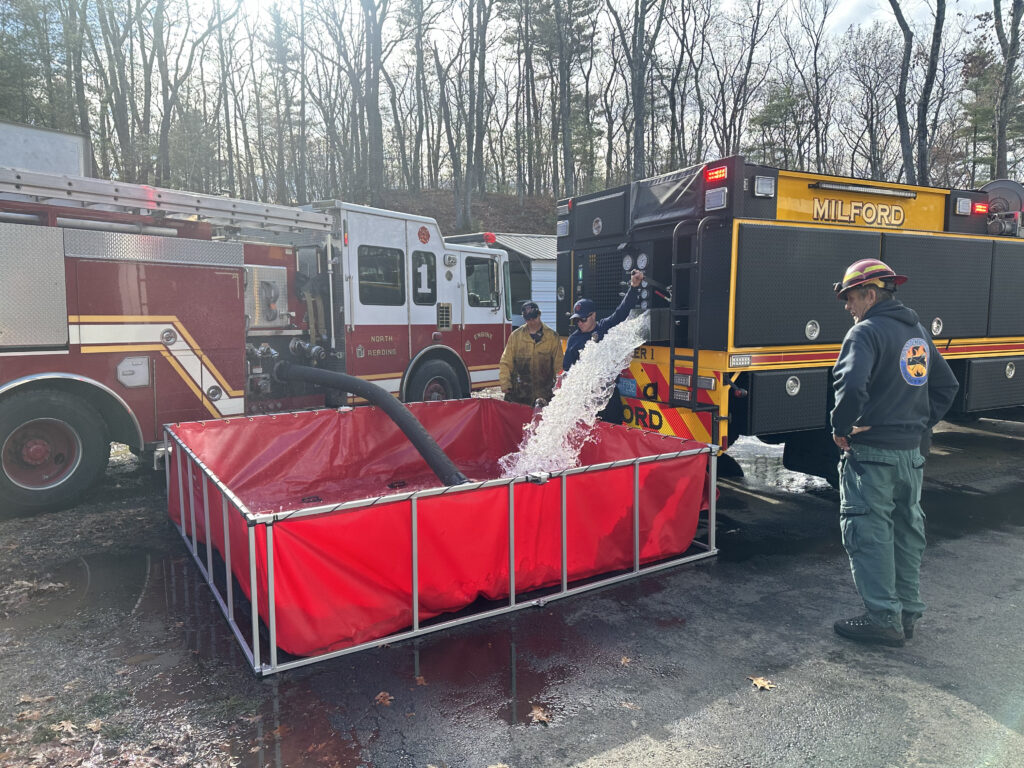
A TANKER TRUCK from the Milford Fire Dept. fills a portable transfer pool up with water while North Reading’s Engine 1 drafts the water from the pool. About 50,000 gallons of water per day on average were needed to fight the massive brush fire behind Dogwood Lane and off Swan Pond over a 17-day period. (NRFD Courtesy Photo)
DPW crews assist
In addition to the work of the firefighters and mutual aid companies shuttling water into the woods using a system of tanker trucks and portable pools to draft from and to feed the firefighting lines that they had staged throughout the woods, a huge part of their success in fighting the fires has been a team of DPW workers now known as the leaf-blowing crew.
Sporting their industrial back pack leaf blowers, they, too, answered the call to help out the firefighters.
“I called them in on Friday (Nov. 8) when the original fire blew back up again and it became much larger,” Stats said. They got a call that night at 7 p.m. of fire in the woods behind Dogwood Lane.
“We got there and there was a lot of fire right behind 3 Dogwood, so I called (DPW Operations Manager) Chris Deming and asked him to get a crew together, if they could. And they came right out, established a fire line in the woods for us behind 3 Dogwood, and then just maintained that the following morning and kept working with us, blowing leaves and creating fire lines, and also cutting trees down wherever we need it, but especially in the fire line so the fire can’t transmit across the fire line,” the chief explained, calling their work “exceptional.”
He had to call them back in at 5 a.m. on Saturday, Nov. 9 due to more flares. With just a little bit of guidance they created the 10- to 15-foot wide swath of area free of unburned leaves that was needed “so that it can’t continue to burn closer toward the house. They did a great job. They worked extremely hard, they never quit and they never said no,” he said. “Their proximity to the fire was close but they kept themselves out of harm’s way due to which way the wind was blowing as well as just not being that close to the fire where they were going to get hurt.”
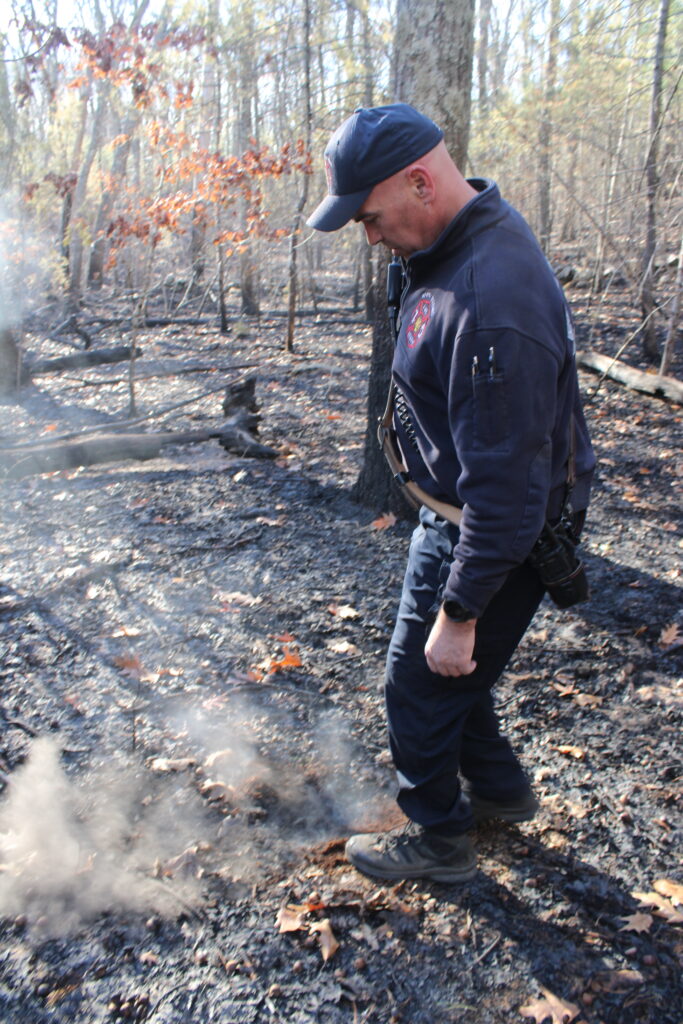
FIRE CHIEF Don Stats tamps down a hot spot in some leaf litter in the woods off Dogwood Lane last Thursday. After 17 days of brush fires that charred 53 acres of woodlands, firefighters removed the hose lines they left set up in the woods earlier that day. (Maureen Doherty Photo)
Community’s response
Stats also wanted to give a shout out to the entire community for their support of his department, in particular, the residents of 3 Dogwood Lane, Nikki and Steffan Tosi, who not only let the Fire Department use their backyard as a staging area but also provided them with coffee, doughnuts, protein bars, water, Gatorade and the use of their bathroom. “They just want to make sure we are taken care of. They are exceptional people,” he said.
Additionally, Rehab Five, a privately funded unit that goes to fire scenes to support firefighters, maintained a kitchen for them for two days.
Donations of food, water and Gatorade too numerous to count were delivered to the Fire Station by the townspeople and businesses, and the chief wanted them to know that any excess supplies have been donated to Rehab Five to support its ongoing operations.
After a long and harrowing Veterans Day weekend, Stats brought in two out of district task forces to give his guys a break. “That means a complement of about 10 different trucks from different parts of the state all helped us fight this fire,” he said. At the end of the day last Tuesday, Nov. 12, he did not have anyone in the woods. Instead, they were monitoring it “to see how stable it is because we feel we are at a good point to do that as well as keeping our guys out of the woods, or any guys out of the woods, because of how windy it is. We had numerous trees come down around us,” he said, explaining, “The fire weakens the tree’s root system and then we’ve had trees come down because of that. And when you add wind on top of all of that, it’s pretty dangerous.”
“This is by far the biggest brush fire I’ve been involved in and we’re doing things that we’ve never done before, such as calling in the task forces to help us and setting up different ways to supply water,” Stats explained, such as using foldable portable pools that are carried on trucks and set up in the field.
“Getting in resources like on the road tanker trucks that are capable of bringing in 2,500 gallons at a time and filling those pools up” he said is a game-changer.
“Logistically, it’s a really challenging operation to manage and set up. We have hoses throughout the woods and it just takes a lot of time and labor to get that in place. It takes a guy or two, depending on the size of the hose line itself, to run that stuff through the woods. It’s very laborious.”
“It truly is the cycle of nature and this has to happen, in my opinion, every 10 to 20 years, in order for the forest to manage itself,” the chief said.
“You would never know that they haven’t gone through this every year, year-in and year-out. It is a well-coordinated operation, and it is a very calm and controlled operation, and you see how much of it is actually manpower-driven,” Town Administrator Michael Gilleberto told the Transcript.
“The firefighters both from North Reading and other communities that have helped us out are all not only doing what they are trained to do in fighting fire but they are doing so in very difficult conditions,” the T.A. continued. After his second tour with the chief on Nov. 12 under much windier conditions, he said, “I can only imagine being out there at night trying to fight the fire, if something would fall on either side of you – it’s a very challenging environment to be in and they’ve done a tremendous job.”
From a big picture perspective, Gilleberto said, the response to fighting 17 days of brush fires has revealed that “we’re blessed with really good people who work for the town and who live in town. And it starts with the firefighters and their hard work, day in and day out for multiple days in conditions where they don’t know what they are going to see next or what the next day will bring.”
Gilleberto added that he believes it is “important for our residents to know that the Fire Chief walks the perimeter of the fire route every morning personally at daybreak. He’s out there in the dark as the sun is coming up evaluating the conditions to be prepared for the Fire Department’s response for that coming day. And he’s done that every day since this began.”
“He has a monitoring route that he is walking every morning. I just did a mid-day walk now and you can see he is trying to distinguish by sight, sound and smell what is going on around him, and trying to distinguish what has already burned from what might be on the verge of burning. And that’s not easy to do, particularly when you are trying to maintain progress walking and deal with the hazards of uneven terrain,” Gilleberto said.
Last Thursday, the firefighters retrieved the dozens of hoses they had snaked throughout the woods and brought them back to the station for a good scrubbing and air-drying. They could finally see the end in sight.

